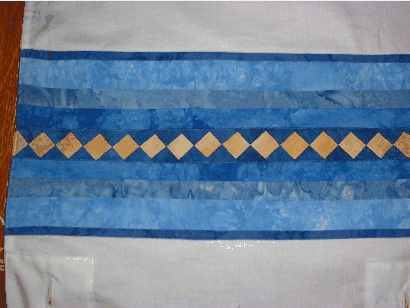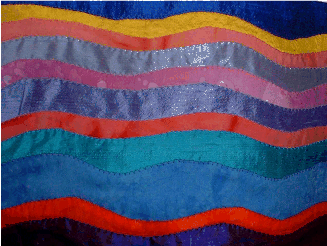
Atarah on a Roll!
New!
Many tallitot feature a long strip along one edge. This collar is called an atarah. It's not required, but it can be beautiful on a tallit. The most common decoration is the prayer said when donning the tallit: Baruch atah adonai elohainu melech haolom asher kidishanu bmitzvotav v'tzivanu l'hit'atef b'tsitzit. (Blessed are you, G-d of the universe, who had commanded us to wear the tzitzit.)
New!
Many tallitot feature a long strip along one edge. This collar is called an atarah. It's not required, but it can be beautiful on a tallit. The most common decoration is the prayer said when donning the tallit: Baruch atah adonai elohainu melech haolom asher kidishanu bmitzvotav v'tzivanu l'hit'atef b'tsitzit. (Blessed are you, G-d of the universe, who had commanded us to wear the tzitzit.)
Because I've had so many requests- - and I do it so often myself - I made up a pattern of this prayer. It fits onto letter-size paper, and this pattern includes directions for cutting out and attaching the strips to make a long strip about 37" total (you can always make it longer by adding space between words or decoration to the ends).
I am happy to send for no charge - just click on the link in the box to the right.
You can then:
I am happy to send for no charge - just click on the link in the box to the right.
You can then:
- Print it out directly on fabric that has been treated to make the ink permanent. (see Photo page). Then cut and sew the strips together on the dotted lines. (Maybe stitch the letter outlines and/or color them in).
- Print it out on paper. Then use the paper as a pattern for stitching, or to cut out applique shapes, or as a stencil, described here.
- Find the same letters in a font you prefer.
- Enlarge or shrink to a size you prefer.

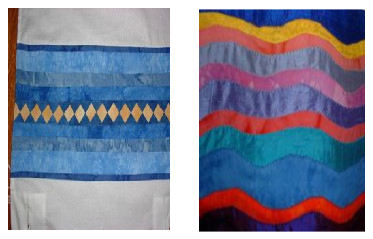
Spring was waning when my friend Maria emailed me from Sweden and asked if I would make her daughter Emi's tallit for the August bat mitzvah, to be held in a forest in upstate New York. Well, of course! I'd been offering for months!
A week later, at Hebrew school pickup, I bumped into my dear friend Pilar. She mentioned that she needed a tallit for her son Leo. She'd long dreamt of making one herself, but since she is not a sewing person, I'd been offering to help her, too. At this point, his bar mitzvah was in….three weeks.
Thus, as summer dawned hot and smoggy (like every other Southern California season), my sewing table was swept clean of quilts, and covered instead with 3 yard cuts of high-quality white fabrics, and my favorite tallit-making literature, (see Resources), mostly quilting books that don't even know they're Jewish.
Making a tallit for a child's Bar or Bat Mitzvah is one of the most sublime pleasures a quilter can undertake.
The best part, as far as I'm concerned, is the Tallit Interview. I ask nosy questions like: What are you into? (Sports? Hobbies? Music? Colors? Textiles? Skateboards? Hebrew school? Ha! ) What's your Torah portion? Haftarah? What do they mean? What's your speech? How do you SEE yourself at this event? Are you happy? Are you nervous? Did you eat enough? I take copious notes, and offer snacks only if necessary.
This process turns up plenty of inspiration. Leo had us doubled over with laughter as he described his portion (in which Moses compared the kvetchy wandering Jews to filthy, ill-tempered she-camels.) We enjoyed lively speculation about the Six Cities of Refuge. (Convicted murderers were sent there, so that relatives of the murderees wouldn't kill them back..)
Then Leo told me his favorite colors - blue and gold. I opened up my fabric cabinets and buried him under a mountain of them.
He surfaced, gasping., and clutching a beautiful hand-dyed medium blue, of which I heartily approved---and an unspectacular brownish gold (a fabric I'd bought because it reminded me of challah crust).
In circumstances like these, I have learned not to argue. I knew the universe would prove the child's color sense better than mine. Not that I'm bitter.
Next, I handed him the book 'Basic Seminole Patchwork,' by Cheryl Grieder Bradkin (C&T Publishing, 1990). About a hundred years ago, the Seminoles came up with intricate-looking but easy straight-line machine piecing designs that are perfect for tallit stripes. (More evidence for my ex-dentist's theory that Native Americans are really lost Tribes of Israel?) Leo picked Design #1 from the book, which fit his personality exactly: Simple, direct and evocative of shining stars.
A week later, at Hebrew school pickup, I bumped into my dear friend Pilar. She mentioned that she needed a tallit for her son Leo. She'd long dreamt of making one herself, but since she is not a sewing person, I'd been offering to help her, too. At this point, his bar mitzvah was in….three weeks.
Thus, as summer dawned hot and smoggy (like every other Southern California season), my sewing table was swept clean of quilts, and covered instead with 3 yard cuts of high-quality white fabrics, and my favorite tallit-making literature, (see Resources), mostly quilting books that don't even know they're Jewish.
Making a tallit for a child's Bar or Bat Mitzvah is one of the most sublime pleasures a quilter can undertake.
The best part, as far as I'm concerned, is the Tallit Interview. I ask nosy questions like: What are you into? (Sports? Hobbies? Music? Colors? Textiles? Skateboards? Hebrew school? Ha! ) What's your Torah portion? Haftarah? What do they mean? What's your speech? How do you SEE yourself at this event? Are you happy? Are you nervous? Did you eat enough? I take copious notes, and offer snacks only if necessary.
This process turns up plenty of inspiration. Leo had us doubled over with laughter as he described his portion (in which Moses compared the kvetchy wandering Jews to filthy, ill-tempered she-camels.) We enjoyed lively speculation about the Six Cities of Refuge. (Convicted murderers were sent there, so that relatives of the murderees wouldn't kill them back..)
Then Leo told me his favorite colors - blue and gold. I opened up my fabric cabinets and buried him under a mountain of them.
He surfaced, gasping., and clutching a beautiful hand-dyed medium blue, of which I heartily approved---and an unspectacular brownish gold (a fabric I'd bought because it reminded me of challah crust).
In circumstances like these, I have learned not to argue. I knew the universe would prove the child's color sense better than mine. Not that I'm bitter.
Next, I handed him the book 'Basic Seminole Patchwork,' by Cheryl Grieder Bradkin (C&T Publishing, 1990). About a hundred years ago, the Seminoles came up with intricate-looking but easy straight-line machine piecing designs that are perfect for tallit stripes. (More evidence for my ex-dentist's theory that Native Americans are really lost Tribes of Israel?) Leo picked Design #1 from the book, which fit his personality exactly: Simple, direct and evocative of shining stars.
Then we hauled the poor kid in front of a full-length mirror and draped him with different sizes of cottons and silks. He preferred cotton, a beautiful thick white Kona. He wanted it narrow, about 15"―another surprise to me (I'd imagined him in something wider)―and a length of 72" (a mystically powerful number. Worked for him).
With Emi, who lives on a farm in rural northern Sweden, I had to do all this electronically. "How do you imagine your tallis?" I emailed. "I can't imagine any tallis," she answered. So I sent her urls where she could look at handcrafted and commercial tallitot, and asked her to tell me what she was drawn to. I also gave her a series of short essay questions. And I told Maria to stand Emi in front of a mirror and drape a variety of Swedish shmatas (horse blankets, sauna towels, milking rags, whatever) around her neck, for size.
I pressed her Brooklyn-born father, Dave, who would be conducting the ceremony, for the religious details. 'What's Emi's full name, and her Hebrew name?,' I asked. Dave wrote back promptly: "Emelie is her proper English name," he told me, "and her Hebrew name is Harvey."
Emi's answers were more coherent. What's the theme of the bat mitzvah reading? "Economic equality and how Jews should be thinking about helping the poor." What are some of her favorite hobbies and activities? "Violin, soccer, small furry animals." What colors might she like? "Mixed."
After a fitting session with her mom, Emi decided she wanted twice the width, but the same length as Leo.
It wasn't a lot to go on. But she also sent me pictures of the tallitot and other Judaica that she admired. She even made up a little drawing.
From those, I perceived that Emi was not interested in the straight stripes of our Seminole machetunim. She was obviously drawn to contemporary designs that featured…. wavy lines. Like ocean waves?
Bummer in the summer. Thus was I forced to take a flying leap into the world of curved piecing - something I had slyly managed to avoid for years.
The rich colors that Emi liked suggested that I should use silk dupioni rather than cotton for her tallit―but dupioni, I learned, frays violently if you look at it twice. (At about $7 a yard in the L.A. fabric district, I rationalized, it is actually less expensive than hand-dyed cottons, thus not obviating her bat mitzvah theme of economic justice).
How to turn dupioni into waves? In desperation, I was forced to crack a book I'd purchased in a frenzied but senseless bidding war on ebay the year before: Vicki Pignatelli's 'Quilting Curves.' (The Quilt Digest Press, 2001).
This technique―which is actually a form of machine appliqué―holds the fabric between layers of stabilizer (on bottom), and freezer paper (on top), giving it virtually no opportunity to fray. It turned out to be perfect for curved designs in dupioni.
With Emi, who lives on a farm in rural northern Sweden, I had to do all this electronically. "How do you imagine your tallis?" I emailed. "I can't imagine any tallis," she answered. So I sent her urls where she could look at handcrafted and commercial tallitot, and asked her to tell me what she was drawn to. I also gave her a series of short essay questions. And I told Maria to stand Emi in front of a mirror and drape a variety of Swedish shmatas (horse blankets, sauna towels, milking rags, whatever) around her neck, for size.
I pressed her Brooklyn-born father, Dave, who would be conducting the ceremony, for the religious details. 'What's Emi's full name, and her Hebrew name?,' I asked. Dave wrote back promptly: "Emelie is her proper English name," he told me, "and her Hebrew name is Harvey."
Emi's answers were more coherent. What's the theme of the bat mitzvah reading? "Economic equality and how Jews should be thinking about helping the poor." What are some of her favorite hobbies and activities? "Violin, soccer, small furry animals." What colors might she like? "Mixed."
After a fitting session with her mom, Emi decided she wanted twice the width, but the same length as Leo.
It wasn't a lot to go on. But she also sent me pictures of the tallitot and other Judaica that she admired. She even made up a little drawing.
From those, I perceived that Emi was not interested in the straight stripes of our Seminole machetunim. She was obviously drawn to contemporary designs that featured…. wavy lines. Like ocean waves?
Bummer in the summer. Thus was I forced to take a flying leap into the world of curved piecing - something I had slyly managed to avoid for years.
The rich colors that Emi liked suggested that I should use silk dupioni rather than cotton for her tallit―but dupioni, I learned, frays violently if you look at it twice. (At about $7 a yard in the L.A. fabric district, I rationalized, it is actually less expensive than hand-dyed cottons, thus not obviating her bat mitzvah theme of economic justice).
How to turn dupioni into waves? In desperation, I was forced to crack a book I'd purchased in a frenzied but senseless bidding war on ebay the year before: Vicki Pignatelli's 'Quilting Curves.' (The Quilt Digest Press, 2001).
This technique―which is actually a form of machine appliqué―holds the fabric between layers of stabilizer (on bottom), and freezer paper (on top), giving it virtually no opportunity to fray. It turned out to be perfect for curved designs in dupioni.
Of course, a tallit is not a tallit-it's just an ungapatchked scarf - until there are tzizis dangling from the corners. Tzizis (sometimes transliterated as tzitzis, tzizit, tzit-tzit, etc.) are a long macramé of 4 thick strings, doubled into 8, dangling from each tallit corner. These strings are tied in a prescribed series of winds and knots, which carry mystical significance. They stand for numbers, which, when interpolated complexly, amount to 613, the number of 'mitzvot,' commandments enumerated in the Torah.
Another meaning: By drawing the eye to the garment's four corners, they remind us that spiritual energy comes from all corners of the universe. Which is about how far I had to drive to buy them.
Many crafters make their own tzizis from strands of perle cotton or other beautiful fibers, but traditionalists feel that the strands must be wool, spun with intention. While I didn't feel that the pedigree of the tzizis would be a huge issue for either of these families, I also wanted to do it right. For that, I had to travel.
My destination, by cosmic coincidence, was a place called '613: The Mitzvah Store.' This well-known Los Angeles Judaica store on Pico Boulevard stocks a vast selection of incipient tzizis packs (That is, the bundled strands, not yet tied).
The store was staffed by shy young men who would only toss monosyllabic fragments of information in my general direction before scurrying to safety behind the mehitza (i.e. the cash register). I was left alone in the anteroom to select tzizis the same way I select wine: The label was beautiful, and the price was mid-range. ( Like, 3 bucks. Seriously, the label said "No Fray," and the slightly vanilla white matched the fabric better than the alternatives.)
Another meaning: By drawing the eye to the garment's four corners, they remind us that spiritual energy comes from all corners of the universe. Which is about how far I had to drive to buy them.
Many crafters make their own tzizis from strands of perle cotton or other beautiful fibers, but traditionalists feel that the strands must be wool, spun with intention. While I didn't feel that the pedigree of the tzizis would be a huge issue for either of these families, I also wanted to do it right. For that, I had to travel.
My destination, by cosmic coincidence, was a place called '613: The Mitzvah Store.' This well-known Los Angeles Judaica store on Pico Boulevard stocks a vast selection of incipient tzizis packs (That is, the bundled strands, not yet tied).
The store was staffed by shy young men who would only toss monosyllabic fragments of information in my general direction before scurrying to safety behind the mehitza (i.e. the cash register). I was left alone in the anteroom to select tzizis the same way I select wine: The label was beautiful, and the price was mid-range. ( Like, 3 bucks. Seriously, the label said "No Fray," and the slightly vanilla white matched the fabric better than the alternatives.)
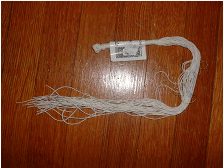
(The other reward for my ordeal in urban parking was the best falafel of my life at an Israeli hole-in-the-wall a block away. The texture! The taste! Back to our story…)
Home at last. Husband takes offspring to swimming pool. Alone, I think about the kids and their 'rents; the Six Cities, the silk, the cotton, the stabilizer, Dave, Harvey, and, most powerful of all, the looming deadlines.
Medico-spiritually speaking, it all gets Vitamixed together in the neurons, the juices run down the toes, out the Bernina pedal, and into the dry goods.
VOILA! A week and not all that much seam-ripping later, out comes a pair of bona fide Hiddur Mitzvot. Beautification of the Commandments. Two tallitot far better than they might have been, because everybody helped: The kids, the parents, Bradkin & Pignatelli, the affluent Swiss sewing machine engineers, the oppressed Chinese silk workers, the falafel chef, my husband, the pool lifeguard, and the ChairOne of the Board . How I love my hobby!
Emi's ocean waves came together like a jigsaw puzzle. Pignatelli's process is a ridiculous amount of fun. And to someone used to working in cotton, the dupioni colors were intoxicating, like drinking a glass of cream after years of skimmed milk.
The dubious crusty gold fabric that Leo chose contrasted brilliantly with the blue. It created an understated, subtle, dignified, masculine and rich effect. Just like Leo.
In the end, I really don't want to keep all the fun to myself. The giftees may not know how to sew, but I felt certain that most of them (except maybe Dave) could tie their shoes, and thus were qualified to tie their tzizis. I had a session with Leo's family, and a session with Emi's family. Everyone got a corner - parents, kids, siblings, good friends.
Home at last. Husband takes offspring to swimming pool. Alone, I think about the kids and their 'rents; the Six Cities, the silk, the cotton, the stabilizer, Dave, Harvey, and, most powerful of all, the looming deadlines.
Medico-spiritually speaking, it all gets Vitamixed together in the neurons, the juices run down the toes, out the Bernina pedal, and into the dry goods.
VOILA! A week and not all that much seam-ripping later, out comes a pair of bona fide Hiddur Mitzvot. Beautification of the Commandments. Two tallitot far better than they might have been, because everybody helped: The kids, the parents, Bradkin & Pignatelli, the affluent Swiss sewing machine engineers, the oppressed Chinese silk workers, the falafel chef, my husband, the pool lifeguard, and the ChairOne of the Board . How I love my hobby!
Emi's ocean waves came together like a jigsaw puzzle. Pignatelli's process is a ridiculous amount of fun. And to someone used to working in cotton, the dupioni colors were intoxicating, like drinking a glass of cream after years of skimmed milk.
The dubious crusty gold fabric that Leo chose contrasted brilliantly with the blue. It created an understated, subtle, dignified, masculine and rich effect. Just like Leo.
In the end, I really don't want to keep all the fun to myself. The giftees may not know how to sew, but I felt certain that most of them (except maybe Dave) could tie their shoes, and thus were qualified to tie their tzizis. I had a session with Leo's family, and a session with Emi's family. Everyone got a corner - parents, kids, siblings, good friends.
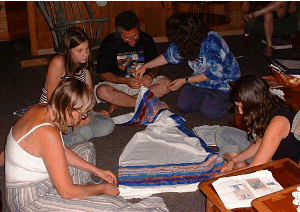
Talk about your kvetchy camels! Just kidding, only a few people kvetched (you know who you are, I won't mention your names here, both of which begin with a "D".) Leo's mom used the experience as the basis for one of her talks at the bar mitzvah, a beautiful metaphor for community, and pretty much the high point of my existence.
At least until the next tallis.
At least until the next tallis.
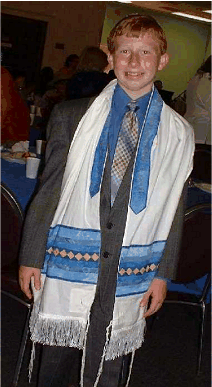
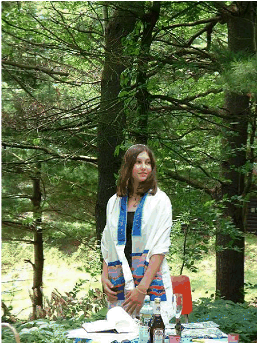
Comments from Dave:
Hej (sic) Cathy and Family!!! Has one of the members of my family answered you previously as I hope they have, however hopeless they may be at taking the time to respond to such polite and heartfelt requests, if so you are free to disregard any or all of this communication. It is early in the morning and my brain is forming thoughts in Swedish, I can feel the Swedish neurons fighting with the mutant english neurons for supremacy, even as I write. We sincerely and heartily approve of your article and the subsequent distribution of it in cyberspace. It is lovely and eloquent, and except for a few small problems, should be very successful. As for the question of royalties paid to Emi, please contact (lawyer friend), esquire of Steven in New Jersey. We are so grateful still for the Tallis, that I nearly don´t dare, (woops, a swedish grammatical infiltration), take up the few small innacuracies regarding the particular stitches and methods used. I believe you underestimate the complexity of the stitch in paragraph 8, line 4, and take a typically Californian, leftist spin, on what is traditionally, in the heartland of America at least, a basic and down to earth means of holding the fabric of our nation together. It is this liberal, intellectual attempt to make the world of stitching and subsequently, the politics of everyday life, into something that we, regular folk, feel is beyond our comprehension, and instead of being alienated we reject this elitism. So, despite the beauty and inherent truth of your quilt, it diminishes my simplistic approach to the world, quilts that warm and hold together, or quilts or even worse, jewish-intellectual tallis-thingys that attempt to overwhelm the good things in life, hard work, dirty fingers, car loans, and even pork. So, I´m voting for Bush. Thank you very much. Love from us."
He's kidding about voting for Bush. Dave's an extreme social welfare state leftist who doesn't know diddley-squat about sewing. Though he conducts a very beautiful bat mitzvah.
Hej (sic) Cathy and Family!!! Has one of the members of my family answered you previously as I hope they have, however hopeless they may be at taking the time to respond to such polite and heartfelt requests, if so you are free to disregard any or all of this communication. It is early in the morning and my brain is forming thoughts in Swedish, I can feel the Swedish neurons fighting with the mutant english neurons for supremacy, even as I write. We sincerely and heartily approve of your article and the subsequent distribution of it in cyberspace. It is lovely and eloquent, and except for a few small problems, should be very successful. As for the question of royalties paid to Emi, please contact (lawyer friend), esquire of Steven in New Jersey. We are so grateful still for the Tallis, that I nearly don´t dare, (woops, a swedish grammatical infiltration), take up the few small innacuracies regarding the particular stitches and methods used. I believe you underestimate the complexity of the stitch in paragraph 8, line 4, and take a typically Californian, leftist spin, on what is traditionally, in the heartland of America at least, a basic and down to earth means of holding the fabric of our nation together. It is this liberal, intellectual attempt to make the world of stitching and subsequently, the politics of everyday life, into something that we, regular folk, feel is beyond our comprehension, and instead of being alienated we reject this elitism. So, despite the beauty and inherent truth of your quilt, it diminishes my simplistic approach to the world, quilts that warm and hold together, or quilts or even worse, jewish-intellectual tallis-thingys that attempt to overwhelm the good things in life, hard work, dirty fingers, car loans, and even pork. So, I´m voting for Bush. Thank you very much. Love from us."
He's kidding about voting for Bush. Dave's an extreme social welfare state leftist who doesn't know diddley-squat about sewing. Though he conducts a very beautiful bat mitzvah.
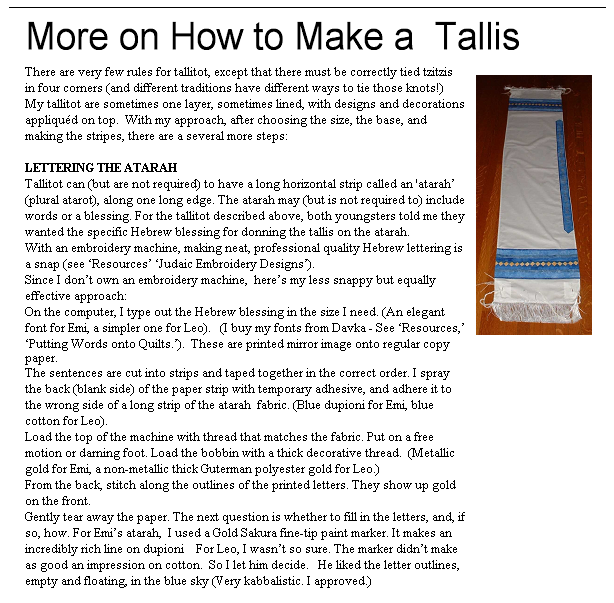

FINISH THE EDGES
The edges of the fabric shawl must be finished. For both tallitot, I turned all four edges under 1/4", twice, and sewed down along the fold with a straight stitch. I sewed commercial white fringe along the hemmed edges (Some people leave the short ends unhemmed, and pull threads to create a decorative fringe that enhances the look of the ritual tzitzis.).
ALIGN, PIN AND APPLIQUE THE ELEMENTS
The stripes must meet exactly the same length down from the center, and up from the ends, when the tallis is folded in half. And the atarah must be centered precisely. My best advice: Measure early and often, in every possible direction.
Once pinned, I sewed down everything to the scarf by machine, with invisible thread on top, white thread on bottom. Finally, I did a little "hand quilting"---a running stitch through two layers---along some of the seams of the pieced stripes and atarah . This kept the strips from poufing.
ADD THE CORNERS
Many tallitot include extra appliquéd squares of fabric in each corner, (called pinot or confes) to stabilize the area where the tzizis will be tied. These are not required, but will make the punctured area much more durable. Buy them from the same people who sell tzizis (see Resources), or make your own. I cut 4" squares from the same white fabric as the scarf base, and fused medium-weight interfacing on the back of each. I then satin-stitched them into position. Finally, I sewed and cut a buttonhole through the middle of each. (You can embellish these squares, too).
The edges of the fabric shawl must be finished. For both tallitot, I turned all four edges under 1/4", twice, and sewed down along the fold with a straight stitch. I sewed commercial white fringe along the hemmed edges (Some people leave the short ends unhemmed, and pull threads to create a decorative fringe that enhances the look of the ritual tzitzis.).
ALIGN, PIN AND APPLIQUE THE ELEMENTS
The stripes must meet exactly the same length down from the center, and up from the ends, when the tallis is folded in half. And the atarah must be centered precisely. My best advice: Measure early and often, in every possible direction.
Once pinned, I sewed down everything to the scarf by machine, with invisible thread on top, white thread on bottom. Finally, I did a little "hand quilting"---a running stitch through two layers---along some of the seams of the pieced stripes and atarah . This kept the strips from poufing.
ADD THE CORNERS
Many tallitot include extra appliquéd squares of fabric in each corner, (called pinot or confes) to stabilize the area where the tzizis will be tied. These are not required, but will make the punctured area much more durable. Buy them from the same people who sell tzizis (see Resources), or make your own. I cut 4" squares from the same white fabric as the scarf base, and fused medium-weight interfacing on the back of each. I then satin-stitched them into position. Finally, I sewed and cut a buttonhole through the middle of each. (You can embellish these squares, too).
BUT IS IT KOSHER?
There are a lot of interesting questions in traditional Judaism about whether a garment is kosher. No, not whether there's shrimp in the fibers---but rather, whether the garment contains a specifically forbidden mixture of linen PLUS wool. Either, alone is fine. But together? That particular combination clearly forbidden in the Torah, twice, for reasons that are never explained. (That, my Hebrew teacher Danny explains, puts it in the category chok, not to be questioned, as distinguished from mitzvoth that are 'explainable by reason.')
This particular prohibition is referred to as shatnes. (also transliterated satnez, shaatnez, etc.) Nonetheless, sages have tried to explain, with rationalizations that run a paradoxical gamut, from the theory that pagan idolaters wore this combination, thus rendering it unclean for Jews, to claims that the ultra-pure Temple priests , the Cohanim, wore the combination, and therefore it's way too good for the rest of us.
And if that's not enough to argue about, there's one more debate: Whether shatnez applies to tallitot. Customarily, the the tzizis are made from wool. So can the scarf itself, or embellishment, contain linen?
To make a long story longer, the answer may depend on how you feel about the authenticity of a potentially extinct Mediterranean snail. Follow me closely here: If only we knew which sea creature made the blue 'techelet' dye for one of the threads in the tzizis of our Biblical foreparents, explained a local shatnez inspector that I called (I found him at http://shatnez.n3.net/) . If we did, and if our tzizis had one of the blue threads made from the right dye from the right snail/fish/?, it would be okay to combine wool tzizis with a linen base. But if we are unsure, his community's feeling is that we must NOT combine linen and wool in our tallit. Got that?
However, other Jewish authorities have told me unequivocally that it is fine to use wool tzizis on a linen scarf . (Some of these people either don't care about the sea creature, or they fervently believe that the right one HAS been identified. Some of these are the same people making and selling blue threads from one or more sea creatures, threads called techelet).
In other words, Jews disagree. (I'm shocked!) My best advice would be this: Avoid combining wool AND linen in a tallit, unless your rabbi (or the rabbi of your giftee) has positively affirmed that he is in the camp that says it's okay, sea creature authenticity not withstanding.
There are a lot of interesting questions in traditional Judaism about whether a garment is kosher. No, not whether there's shrimp in the fibers---but rather, whether the garment contains a specifically forbidden mixture of linen PLUS wool. Either, alone is fine. But together? That particular combination clearly forbidden in the Torah, twice, for reasons that are never explained. (That, my Hebrew teacher Danny explains, puts it in the category chok, not to be questioned, as distinguished from mitzvoth that are 'explainable by reason.')
This particular prohibition is referred to as shatnes. (also transliterated satnez, shaatnez, etc.) Nonetheless, sages have tried to explain, with rationalizations that run a paradoxical gamut, from the theory that pagan idolaters wore this combination, thus rendering it unclean for Jews, to claims that the ultra-pure Temple priests , the Cohanim, wore the combination, and therefore it's way too good for the rest of us.
And if that's not enough to argue about, there's one more debate: Whether shatnez applies to tallitot. Customarily, the the tzizis are made from wool. So can the scarf itself, or embellishment, contain linen?
To make a long story longer, the answer may depend on how you feel about the authenticity of a potentially extinct Mediterranean snail. Follow me closely here: If only we knew which sea creature made the blue 'techelet' dye for one of the threads in the tzizis of our Biblical foreparents, explained a local shatnez inspector that I called (I found him at http://shatnez.n3.net/) . If we did, and if our tzizis had one of the blue threads made from the right dye from the right snail/fish/?, it would be okay to combine wool tzizis with a linen base. But if we are unsure, his community's feeling is that we must NOT combine linen and wool in our tallit. Got that?
However, other Jewish authorities have told me unequivocally that it is fine to use wool tzizis on a linen scarf . (Some of these people either don't care about the sea creature, or they fervently believe that the right one HAS been identified. Some of these are the same people making and selling blue threads from one or more sea creatures, threads called techelet).
In other words, Jews disagree. (I'm shocked!) My best advice would be this: Avoid combining wool AND linen in a tallit, unless your rabbi (or the rabbi of your giftee) has positively affirmed that he is in the camp that says it's okay, sea creature authenticity not withstanding.
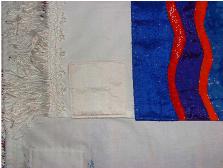
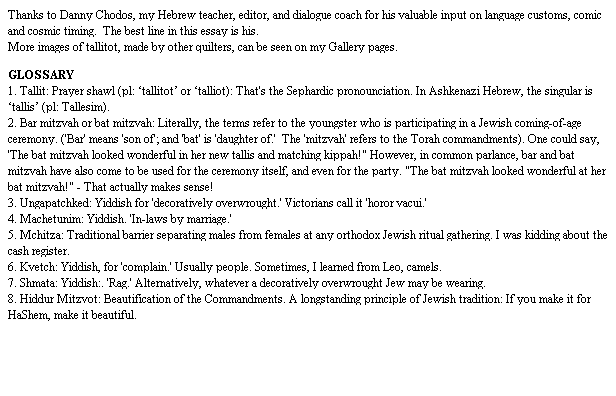


Tallit Links and Learning
Plain white tallitot (for embellishment), tzitzit. and atarot (optional rectangular collar bands), can be purchased from many different Jewish supply stores, or mail order. Possibilities:
- Pure inspiration. When it comes to gorgeous handmade tallitot using quilting techniques and machine embroidery, no quilter does it better than my friend Marilyn Levy.
- Learn how to tie the tzitzit. at this informative site: http://www.scheinerman.net/judaism/tallit/index.html
- More tzitzit tying directions:http://www.hanefesh.com/edu/Tzitzit_Shawl_Prayer.htm#cu
- Tallit instructions, first person. N.Amanda Ford wrote a fascinating essay and instruction sheet for making a tallit, at http://6millionstitches.clicksitebuilder.com/index.html, Click on the page titled 'Directions1', and scroll down.
- 'The Jewish Catalogue, a Do-It-Yourself Kit,' by Richard Siegal, et. al., published by The Jewish Publication Society of America, has excellent tallit and tzittzit tying instructions. Find it at used book sites.
- Shatnez Information Explains Torah law on fiber mixing. http://shatnez.n3.net/.
- The Crafty Needle (formerly California Stitchery), has many needlepoint kits and canvases for tallit cases and atarot; but most relevant to quilters are their 'how to' books, 'On Making A Tallit,' by Marilyn Eisenman, and 'Tallit Traditions,' by Bobbie Premack.
Plain white tallitot (for embellishment), tzitzit. and atarot (optional rectangular collar bands), can be purchased from many different Jewish supply stores, or mail order. Possibilities:
- Ziontalis, at 1026 6th Avenue, Suite 402, Between 38th and 39th Sts., NY, NY, 10018; tel. 800.219.9809 or 212.643.8869. Email: ziontalis@aol.com; website: www.ziontalis.com. Click on 'Products', then 'Talit Accessories'.
- The 613 Mitzvah Store, 9400 W. Pico Blvd, Los Angeles, CA 90035. Tel. 310.247.9613. No website, but if you live in or near LA, this is the place to drive for tzitzit. A wide assortment of sets, all of them wool, guaranteed kosher, with prices ranging from about $2 a set to $12 and more.


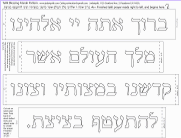
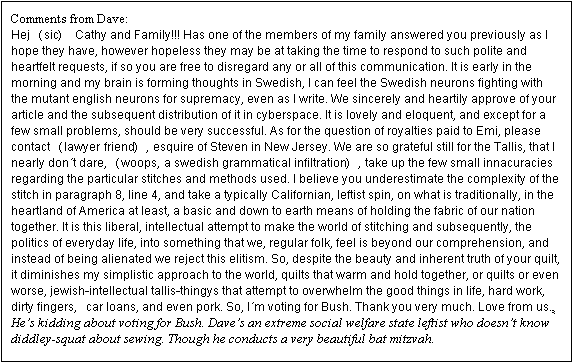
This pattern can be downloaded as a PDF; click here.
